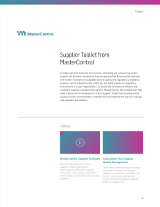
GxP Lifeline
The Role of Supply Agreements in Life Sciences Manufacturing

The COVID-19 pandemic has had an extraordinary impact on supply chains. Across the globe, life sciences organizations that rely on supply chains to provide protective or life-saving products have experienced the pandemic’s disruptive effect, no matter the complexity of their supply chain.
In light of the disruption and the urgency around fast delivery of high-quality products, it makes sense that manufacturers and their suppliers might reassess their relationships and obligations to one another to manage the results of disruption to supply chain partners.
An assessment of supplier relationship roles, rights, and obligations starts with reviewing and understanding relevant supply agreements.
Why Use a Supply Agreement
A supply agreement should be used in any business partnership between a manufacturer and supplier. For the purchasing manufacturer, a supply agreement helps ensure they receive the materials or goods they need at specified times and for the agreed-upon price, providing the company some protection from supply issues. For the supplier providing the materials or goods, such an agreement takes the guesswork out of how and when materials or goods should be provided to the customer. For both parties, the supply agreement makes planning easier.
What a Supply Agreement Should Cover
A supply agreement should set clear expectations. It may vary from company to company, but there are some key contract provisions commonly included when life sciences organizations draft supply agreements1,2:
- Scope – including requirements, output, and exclusivity; commitment to supply/allocation of supply (in case of supply shortage); and subcontractor information (approval required, etc.).
- Duration – including stipulating how long the agreement will be in place; whether it will be for a specific period; if it will automatically renew; and if a new contract needs to be signed each year.
- Ordering – including order size and lead time, stating minimum and maximum orders; and purchase order information (purchaser acceptance/rejection, delivery date, etc.).
- Price and payment – including detailing the price and payment terms; whether there will be discounts for larger orders; what the costs are for late payments; and cost changes over time.
- Confidentiality and proprietary information – including clearly defining what information is confidential to protect proprietary information from competitors.
- Raw materials sourcing – including supplier’s establishment of appropriate contracts with suppliers of raw materials; and establishment of secondary supply sources.
- Product labeling and packaging – including changes to labeling and packaging; patent marking; packaging standards (quality agreement); and equipment inspection rights.
Supply Agreement or Supplier Quality Agreement
Supply agreements are not supplier quality agreements. Where a quality agreement between a manufacturer and supplier is intended to formally outline specific quality parameters and responsibilities relative to quality and regulatory requirements to ensure supply of safe materials, a supply agreement outlines the parameters, terms, and conditions of a business relationship between a manufacturer or the supplier of the materials.
While the U.S. Food and Drug Administration (FDA) recommends supply agreements and supplier quality agreements be separate documents, the quality agreement may be included by reference in the main supplier agreement.
Conclusion
Manufacturer-supplier relationships should always be built on communication, collaboration, and a mutually beneficial partnership. Otherwise, risks grow greater in likelihood and consequence. If there are issues hindering supplier performance, the manufacturer and supplier should work together to resolve those issues quickly. Working with your supply partners to achieve their obligations starts with understanding your company’s existing supply agreements.
Resources:
- “Emerging Life Sciences Companies: Key Contract Provisions for Supply and Manufacturing Agreements,” Morgan Lewis.
- “Manufacturing and Supply Agreements,” Edwards Angell Palmer & Dodge LLP.
Free Resource

Enjoying this blog? Learn More.
Free Resources to Boost Your Supplier Management System
Download Now